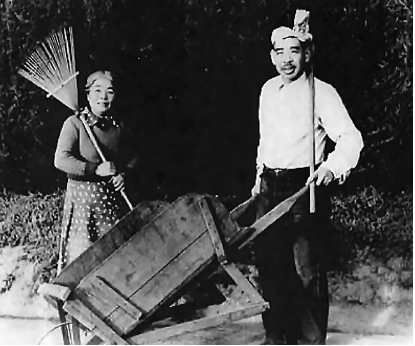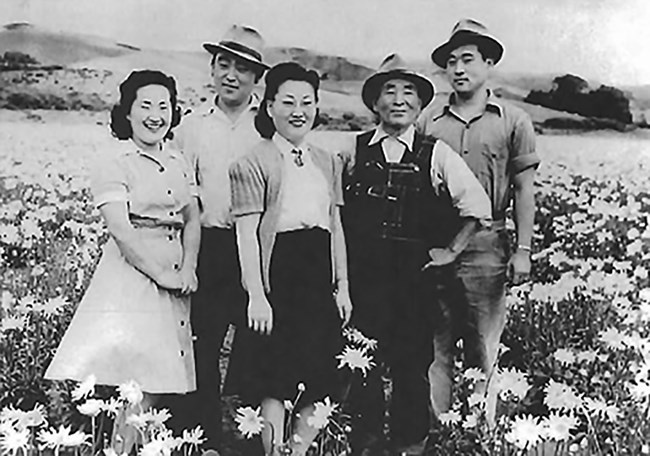Last updated: January 27, 2022
Article
Japanese at Rancho Corral De Tierra
Before World War II, two Japanese families came to cultivate lands now a part of the Golden Gate National Recreation Area, the Takahashis and the Satos. Both their stories have historical importance. The first one is about a pioneer horticulturalist and leader of his community. The second is about the struggles of a farm family faced with internment and ruin.

Y. Takahashi
San Mateo County Japanese American families always referred to the head of the first family as Mr. Takahashi. One source describes his flower growing enterprise just east of Montara as “a tiny nursery”114that launched the strawflower industry in San Mateo County. Another proclaims it “a large Japanese garden of flower terraces and fish ponds…that…is credited with starting the strawflower industry in the United States.”115 A photograph taken by the San Francisco Flower Market in 1940 shows Takahashi and his wife Kiku in front of a large hedge in front of his land saying “Welcome”. The 1920 Census indicates that both could speak English. It tells us that Takahashi owned his house outright - - that is he paid no mortgage. In part his property existed on the eastside of Sunshine Valley Road where horse stables for Renegade Ranch are today, on the Golden Gate National Recreation Area’s portion of Rancho Corral de Tierra. It is reported that Mr. Takahashi was a former professor of horticulture from the University of Tokyo, and that he introduced the first dehydration chamber at Montara in 1911. He started out by selling flowers on the San Francisco market, using the Ocean Shore Railroad to transport his products.117
Local Japanese families remember this Issei and his Issei wife as kind and respected, but childless.118 For years Takahashi was noted for inviting students from Japan to study his gardens. One of the professor’s initiatives, at least as far back as the 1930s, was to bring orphaned teenage boys from San Francisco and other places to his farm where they worked until they finished school at Half Moon Bay High. One of these boys, Hero Ogo, became a farmer in the area himself, on a parcel of land where Half Moon Bay Airport is today.119By 1942, when coastside Japanese were evacuated because of the start of World War II, Takahashi was in his 60s. At the Assembly Center at Tanforan Race Track in San Bruno, Japanese people from the Corral de Tierra area, from Frenchman’s Creek up to his property, kept close to him. After the War, Takahashi was one of the few to regain his land. He took in other, less fortunate, former internees until they could get back on their feet. Local residents of Montara used to speak of Takahashi “as a short, little man taking his daily walks up and down Sunshine Valley Road.”120 Mrs. Takahashi died after the War. Mr. Takahashi outlived her and moved to San Francisco.121 He expired sometime in the 1950s or 1960s.122

The Sato Family
Just after World War II, Seiro Sato and his son Hamm came to live up Denniston Creek on land on the eastern portion of Cabrillo Farms on today’s Rancho Corral de Tierra lands of Golden Gate National Recreation Area. Seiro was born in 1872 at Kochi, a prefecture in Japan. He was the oldest son in his family and decided to come to the United States in 1890. At first he settled on lands near Stockton, California and did well as a farmer. More than a dozen years later, he decided to return to Kochi to find a wife. He met Masao Hara, who became impressed with Sato’s success in America. They were married and the couple eventually had two sons, Hamm and Sam, and daughters Sue (now Sue Okamura) and Yoshi (now Yoshi Mizono). After Masao died of cancer, Seiro moved the family to San Mateo in 1928. Here he worked as a gardener but longed to be a farmer again. By 1932, he had his family in motion once more. They leased property over the hill at Frenchman’s Creek, north of Half Moon Bay, where Seiro decided to get into the flower growing business.124 He grew marguerites125 (chrysanthemums) and strawflowers.
Close by were other Japanese families. The Katos lived at Miramar, east of the highway, and the Ogos, as mentioned above, lived at the present site of Half Moon Bay Airport.126 Further north were the Takahashis. According to daughter Sue Okamura, the home they lived in was a comfortable two story farmhouse that, by the beginning of World War II, was fully equipped with modern utilities. A photograph, taken in 1940, by the San Francisco Flower Market, shows a happy and proud Seiro, with two sons and two daughters.
World War IIIn the weeks after the attack on Pearl Harbor, negative feelings manifested themselves in the Bay Area. Mizono remembered how the son of a prominent Half Moon Bay family planted nails in the driveways of people of Japanese ancestry of the town.127 When the evacuation order came, some of the Japanese families on the coast gathered at the Satos’ as a sort of staging area.128 On eviction day, the Satos joined other Japanese of the County at the Masonic Hall in San Mateo. Mizono recalled how “kind ladies from the Congregational Church” served the people coffee and cookies.129 Buses then took them to the Assembly Center at Tanforan. After some months there, it was on to Camp Topaz in Utah. Mizono remembered upon arriving there “…it was so desolate. I was never so depressed in my whole life.”130 In 1943, the Sato brothers were presented with a questionnaire from the federal government. Two key questions asked if they would be willing to sign up for the armed forces and if they were ready to disclaim loyalty to the Emperor of Japan and instead proclaim allegiance to the United States.131 Sam had bad knees and a hurt back. As a “4-F,” his determination to say “yes” had no real impact.132 However, Hamm said “no” to both and told an FBI agent: “I’m putting no-no, because you look up in the dictionary and see what allegiance means…swearing allegiance to a country that’s going to protect you.”133 Yoshi Mizono found some relief from the hardships of camp in religion. She attended Bible class once a week. She asked her father and older sister if she had ever been baptized. They could not remember; so on Easter Sunday, 1943, she was baptized with others on a platform, during a sunrise service.134 That same year, the 21 year old left Topaz to attend nursing school in Pennsylvania.135 Her older sister, Sue, was married that year to a Nisei serving in the Army. For some months she lived away from Topaz, but when he was discharged in 1945, the couple returned to camp.136 When the War ended, the family was finally allowed to go back to San Mateo County. Sam Sato remembered coming through Vallejo and seeing the fog: “It sure reminded me of the coastside. Something that I felt really good about inside - - coming back to the coast after four years.”137 Of course the Satos had no idea what they were coming home to. Sam recalled that coastside artist Galen Wolfe kept the family’s personal belongings in his barn. Wolfe reportedly had to protect these possessions from his brother, who wanted to burn them. Wolfe threatened his sibling with his shotgun, and that saved the Satos’ things. Later, when one of Sam’s sisters gave birth, she named the boy Galen after this friend.138 In the Spring of 1947, Seiro and Hamm decided to get back into farming and leased acreage from an Italian family.139 The land they occupied is east of the present Cabrillo Farms buildings, beyond the Denniston Reservoir at the base of the hills on the National Park’s Corral de Tierra. Their “house” was nothing like the old farmhouse at Frenchman’s Creek. The two men built what was really a one or two room shack. They had no money, built no green house or hardly any other improvements. There were no utilities. Fresh water came from the Creek. They cleared the land and grew flowers and some vegetables. Sue Okamura remembered it as “a real something.”140 Later, they built a second place, further up the canyon from the first. This was a nicer affair. It had plumbing - - even a toilet. The two lived here as bachelors until about 1960.141
|
